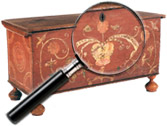|
|
Shaker Crafts
Shaker crafts were the product of the United Society of Believers – the Shakers – who lived in twenty “communities” throughout the northeast and mid-west. Shakers were active from about 1790 to 1900, with most of their crafts produced in the 1820 to 1870 period. Shaker wares are characterized by simple, plain design. They feature severe lines, minimal ornamentation and very high craftsmanship. The Shakers believed that outward appearances should reflect the [...] Click here to continue reading.
The Classical Period, 1800 to 1840
Some may find the Classical Period of American furniture to be somewhat confusing as it overlaps that of the Federal Period. This confusion may be particularly acute among dealers and collectors of country American furniture, for while we do see many pieces of fine Federal furniture, we less frequently see examples of Classical furniture and, when we do, there is seldom anything country in its form or finish. [...] Click here to continue reading.
Georgian Furniture
Georgian furniture refers to the evolution of styles popular during the reigns of the Hanoverian monarchs George I, II and III in 18th-century England. The period was one of remarkable prosperity and stability, and the decorative arts reflect this settled time. Thomas Chippendale, Robert Adam, Thomas Sheraton and George Hepplewhite are all 18th-century British designers whose pattern books became popular not only in England, but around the world, most notably in the [...] Click here to continue reading.
Tri-Symmetric by Vladimir Kagan
Vladimir Kagan’s Tri-Symmetric line was introduced in 1955 and remains in production. The furniture takes its name from the symmetrical nature of the three legs that support the pieces.
The Victorian Period, 1840 to 1890
Solely by being possessed of good genes and a solid constitution does Queen Victoria gain the distinction of having her name attached to one of the more interesting periods of history and furniture design. As an individual she lent little to the design field and with the exception of Gothic Revival at the beginning of the period and Eastlake at the end, Great Britain itself contributed little. France [...] Click here to continue reading.
Blanket Chest or Dower Chest?
The rectangular wooden lift-top storage box is a widely identified furniture form often associated with Pennsylvania German decorative arts. Utilitarian in design, it features a lift top, iron hardware and usually rests on feet. The form was brought over from Europe and dates back to the Middle Ages. Sometimes referred to as a “dower chest” or “hope chest,” the preferred terminology is “blanket chest.”
A general confusion [...] Click here to continue reading.
The Colonial Period of American Furniture, 1720 to 1783
Technically, when we discuss American Furniture periods, we could begin the Colonial period all the way back to 1610 as the first settlements were indeed colonies of England and Holland. However, the term Colonial Period did not come into use until the 1920′s and by then the colonial 17th century had been designated the Pilgrim Period. To further confuse the novice, you will find many [...] Click here to continue reading.
Frank L. Horton
The co-founder of the Museum of Early Southern Decorative Arts (MESDA) and a major contributor to the planning and restoration of Old Salem, the living history museum in Winston-Salem, North Carolina, Frank L. Horton passed away February 21, 2004. He was 85 years old.
The enormous impact that Horton made on the field of antiques is readily acknowledged by American decorative arts scholars. His contributions to historic preservation are easily recognized [...] Click here to continue reading.
The Federal Period (1790 to 1830)
The Federal Period in American furniture history covers an important time frame in the formation of the United States. It begins just after the joining of the original 13 colonies with 2.5 million people into the first 13 states of the Union in 1787/1788 and it ends in 1830 with Andrew Jackson as the 7th President, 24 states in the Union and a population of approximately 12.8 million [...] Click here to continue reading.
Maple & Co.
Established in 1841 on the Tottenhan Court Road in London by a 26 year old John Maple, Maple & Co. was a designer, decorator, builder, manufacturer and, most of all, a retailer of fine furnishings to the English carriage trade. At its peak in Edwardian London, Maple & Co was known as “The largest and most convenient,” not just in the West End of London or London as a whole or [...] Click here to continue reading.
|
Recent Articles
- Charles Alfred Meurer – American Artist & Tromp L’Oeil Artist
- Sendak, Maurice – American Artist & Writer
- Godie, Lee – American Artist
- Davis, Vestie – American Artist
- Bartlett, Morton – American Artist
- Mackintosh, Dwight – American Artist
- Evans, Minnie Jones – African-American Artist
- Mumma, Ed (Mr. Eddy) – American Artist
- Nice, Don – American Artist
- Savitsky, John (Jack) – American Artist
- Gordon, Harold Theodore (Ted) – American Artist
- Dial, Thornton – African-American Artist
- Doyle Sam – American Artist
- Johnson, Lester Frederick – American Artist
- Finster, Howard – American Artist
|
|
